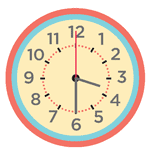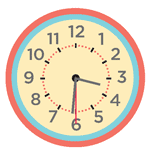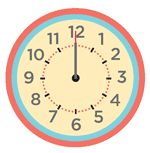Hours, Minutes, and Seconds
The three scales on a clock—hours, minutes, and seconds—form the basis for many different puzzles. This puzzle asks if the scales align more than twice each day.
 A clock is a complicated measuring device. There are three scales superimposed on each other, one for hours, one for minutes, and one for seconds.
A clock is a complicated measuring device. There are three scales superimposed on each other, one for hours, one for minutes, and one for seconds.
On the clock shown here, the hours are numbered and there are marks for each minute. We all know that the minute hand on the 6 represents 30 minutes, not 6 minutes past the hour. Since the hour hand is between 3 and 4 and the second hand is at 12, we know that the time is 3:30:00.
In this puzzle we introduce an idea of the “minute position” of the hour hand. At 3:30:00, the minute position of the hour hand is 17 1/2 minutes. The hour hand is pointing at the 17 1/2-minute mark on the clock face, because that is the minute position exactly halfway between the hours of 3 and 4.
 At 3:30:00, and any time that the minute hand points exactly to one of the minute marks, the second hand points to the 12. By the time the second hand has moved another 30 seconds, so that the time is 3:30:30, the minute hand will have moved halfway to the next minute mark, as shown below. (The hour hand will have moved a tiny bit as well.)
At 3:30:00, and any time that the minute hand points exactly to one of the minute marks, the second hand points to the 12. By the time the second hand has moved another 30 seconds, so that the time is 3:30:30, the minute hand will have moved halfway to the next minute mark, as shown below. (The hour hand will have moved a tiny bit as well.)
Another important convention about clocks and time is that the minute, hour, and second hands start counting at zero, every time they sweep through a full revolution on the clock. Every 12 hours the hour hand starts over at 0. Also, every 60 minutes, the hour hand moves five “minute places” further along and the minute hand starts over at 0. Similarly every 60 seconds the minute hand moves one minute place further along and the second hand starts over again at 0.
 When the hour, minute, and second hands point to 12, the time is 12:00:00, which could also be called 00:00:00.
When the hour, minute, and second hands point to 12, the time is 12:00:00, which could also be called 00:00:00.
Now here’s your puzzle.
The hour, minute, and second hands are exactly aligned with one another at 12:00. There may be some other times when all three hands are close to one another; however, is there any time other than 12:00 that all three hands line up exactly?
On some clocks the second hand moves in “ticks,” pausing briefly at each mark on the clock face. For this puzzle, assume that the hour, minute, and second hands of the clock move continuously.
Hints:
To solve this problem, it would be best to answer the following questions first:
- How many times in a 12-hour cycle for the hour hand are the hour and minute hands exactly aligned with each other? Can you determine the specific times those occur in hours, minutes, and seconds?
- How many times in a 1-hour cycle are the minute and second hands exactly aligned with each other? Can you determine the specific times those occur in minutes and seconds?
Background
The mathematics of time is complicated partly because of the cyclical nature of time measurement. Cyclical arithmetic, also called modular arithmetic and sometimes called “clock arithmetic”, is an important branch of mathematics and has many applications in science. Our normal numbering starts at zero and continues on forever with larger and larger positive and negative numbers. Cyclical or modular numbers also start at zero and begin to increase until a certain value is reached, at which point they start again at zero. Arithmetic problems in such systems have a beauty and difficulty all their own.
The mathematics of time is also complicated because we use so many different, although related units. Arithmetic problems involving time can be extremely complex. Think about it: 60 seconds per minute, 60 minutes per hour, 24 hours per day, 365 days per year. Not to mention weeks and months! (The convention for hours, minutes, and seconds goes back to the ancient Babylonian convention of dividing a circle into 360 degrees.)
The system defies logic! Indeed, at the time of the French Revolution, French scientists proposed that the world adopt a new system for time measurement based on decimal arithmetic. After all, their metric system had become standard throughout the world. Why not have a metric system for time? In the French Revolutionary system the year had ten months, thirty days each; each month had three ten-day weeks; each day ten hours; each hour 100 minutes; each minute 100 seconds. The French system is described in Wikipedia [1].
Metric time never caught on for many reasons. For one thing, all the clocks and watches already in existence would have become obsolete!
This content has been re-published with permission from SEED. Copyright © 2025 Schlumberger Excellence in Education Development (SEED), Inc.
Course:
- Math [2]
- Time Mathematics [3]
- Time Puzzle [4]
- Clock Puzzle [5]
